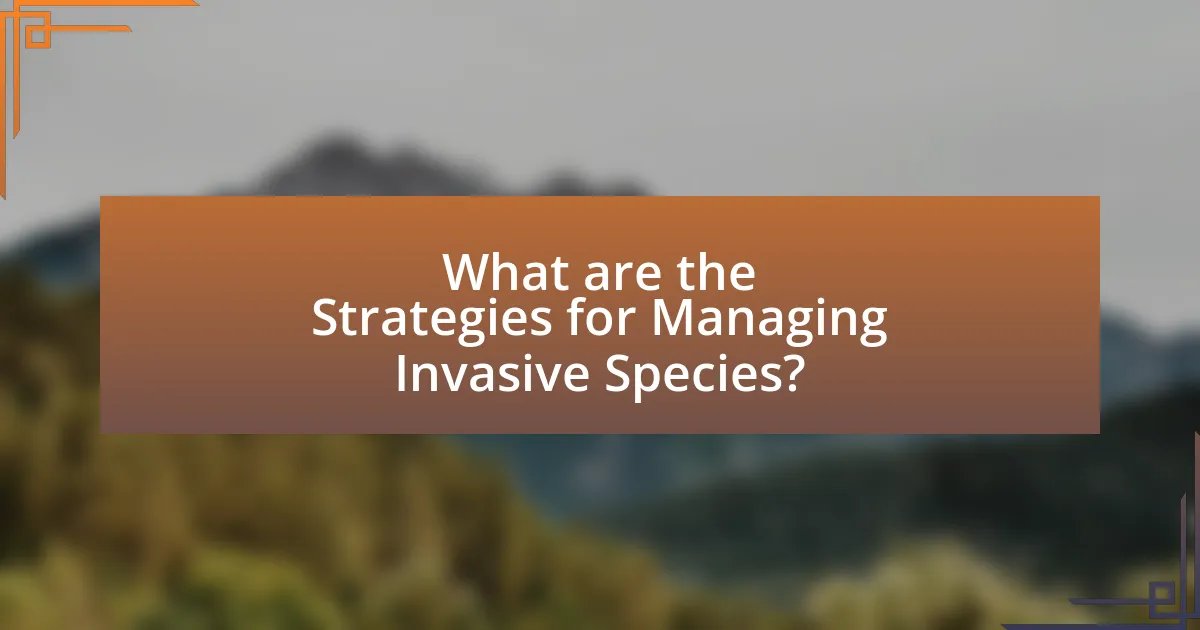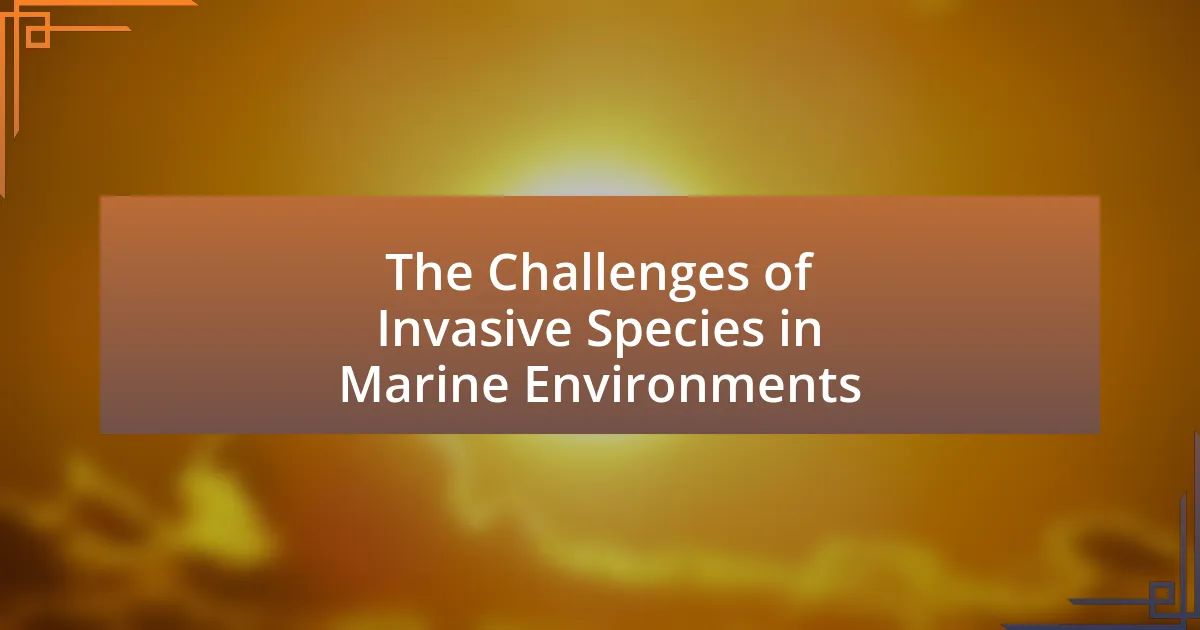Invasive species in marine environments are non-native organisms that disrupt local ecosystems and biodiversity, often leading to significant ecological and economic consequences. This article examines the pathways through which these species enter marine ecosystems, primarily through human activities such as shipping and aquaculture. It highlights the ecological impacts of invasive species, including their effects on native marine life and fisheries, as well as the economic implications for local industries. Additionally, the article discusses management strategies, including prevention, control methods, and the importance of stakeholder collaboration and research in addressing the challenges posed by invasive species in marine environments.

What are Invasive Species in Marine Environments?
Invasive species in marine environments are non-native organisms that, when introduced to a new habitat, disrupt local ecosystems and biodiversity. These species often outcompete native species for resources, alter habitats, and can introduce diseases. For example, the lionfish, native to the Indo-Pacific, has invaded the Caribbean and Atlantic, leading to significant declines in local fish populations and altering reef ecosystems. The introduction of invasive species can result in economic impacts, such as decreased fisheries yields and increased management costs, highlighting the importance of monitoring and controlling these organisms to protect marine biodiversity and ecosystem health.
How do invasive species enter marine ecosystems?
Invasive species enter marine ecosystems primarily through human activities such as shipping, aquaculture, and recreational boating. These activities facilitate the unintentional transport of organisms across geographical barriers, allowing them to establish in new environments. For instance, ballast water taken on by ships in one location often contains a variety of marine organisms, which can be released in a different location, leading to the introduction of non-native species. According to the National Oceanic and Atmospheric Administration (NOAA), ballast water is responsible for the introduction of approximately 7,000 species into U.S. waters each year. Additionally, the release of aquarium species and the escape of farmed species into the wild further contribute to the spread of invasive species in marine ecosystems.
What are the primary pathways for the introduction of invasive species?
The primary pathways for the introduction of invasive species include shipping, aquaculture, and the aquarium trade. Shipping is a significant pathway, as vessels can transport organisms in ballast water, which can be discharged in new locations, leading to the establishment of non-native species. Aquaculture practices often involve the introduction of species for farming, which can escape and disrupt local ecosystems. The aquarium trade contributes to invasions when individuals release non-native species into the wild, intentionally or accidentally. These pathways are well-documented, with studies indicating that shipping is responsible for approximately 70% of marine invasions, highlighting the critical need for management strategies to mitigate these risks.
How do human activities contribute to the spread of invasive species?
Human activities significantly contribute to the spread of invasive species through mechanisms such as global trade, transportation, and habitat alteration. For instance, the shipping industry facilitates the unintentional transport of invasive organisms in ballast water, with studies indicating that over 7,000 species are transported globally each day via ships. Additionally, the introduction of non-native species for aquaculture or ornamental purposes often leads to their escape into natural ecosystems, where they can outcompete native species. Urban development and agriculture further disrupt local habitats, creating conditions that favor invasive species establishment. These activities collectively enhance the likelihood of invasive species spreading and establishing in new environments, posing threats to biodiversity and ecosystem health.
Why are invasive species a concern for marine environments?
Invasive species are a concern for marine environments because they disrupt local ecosystems, outcompete native species, and can lead to significant biodiversity loss. For instance, the introduction of the lionfish in the Caribbean has resulted in the decline of native fish populations, as lionfish have no natural predators in these waters. This disruption can alter food webs and negatively impact fisheries, which are vital for local economies. Additionally, invasive species can introduce diseases and parasites that further threaten native marine life, exemplifying their detrimental effects on marine biodiversity and ecosystem health.
What ecological impacts do invasive species have on native marine life?
Invasive species significantly disrupt native marine life by outcompeting them for resources, altering habitats, and introducing diseases. For instance, the introduction of the lionfish in the Caribbean has led to a dramatic decline in native fish populations due to its predatory behavior and lack of natural predators in the region. Studies indicate that lionfish can reduce native fish populations by up to 80% in affected areas, demonstrating their profound ecological impact. Additionally, invasive species can modify the physical environment, such as the introduction of the green crab, which alters the structure of coastal ecosystems, further threatening native species.
How do invasive species affect marine biodiversity?
Invasive species negatively impact marine biodiversity by outcompeting native species for resources, disrupting food webs, and altering habitats. For instance, the introduction of the lionfish in the Caribbean has led to significant declines in native fish populations due to its predatory behavior and lack of natural predators. Studies indicate that invasive species can reduce native biodiversity by up to 50%, as they often thrive in new environments and exploit resources more efficiently than indigenous species. This disruption can lead to a loss of ecosystem services, affecting the overall health and resilience of marine ecosystems.
What are the economic implications of invasive species in marine environments?
Invasive species in marine environments have significant economic implications, primarily through the disruption of local fisheries and ecosystems. These species can outcompete native organisms for resources, leading to declines in commercially important fish populations, which in turn affects the livelihoods of fishermen and related industries. For example, the introduction of the lionfish in the Caribbean has resulted in substantial declines in native fish stocks, costing the fishing industry millions of dollars annually due to reduced catch and increased management costs. Additionally, invasive species can damage infrastructure, such as ports and marinas, leading to increased maintenance and repair expenses. The overall economic burden of invasive species in marine environments is estimated to reach billions of dollars globally, highlighting the need for effective management and prevention strategies.
How do invasive species impact fisheries and aquaculture?
Invasive species negatively impact fisheries and aquaculture by disrupting ecosystems, outcompeting native species, and altering food webs. For instance, species like the zebra mussel can clog water intake systems, affecting fish populations and aquaculture operations. Additionally, invasive predators, such as the lionfish in the Caribbean, significantly reduce native fish populations, which are crucial for both commercial and recreational fishing. According to a study published in the journal “Biological Invasions,” the economic losses attributed to invasive species in fisheries can reach billions of dollars annually, highlighting their detrimental effects on both biodiversity and the fishing industry.
What costs are associated with managing invasive species?
Managing invasive species incurs various costs, including prevention, control, and restoration expenses. For instance, the U.S. spends approximately $120 billion annually on invasive species management, which encompasses research, monitoring, and eradication efforts. Additionally, the economic impact on fisheries and tourism can reach billions, as invasive species disrupt ecosystems and reduce biodiversity. Specific examples include the costs associated with controlling the lionfish in the Caribbean, which can exceed $5 million per year for targeted removal and public awareness campaigns. These figures highlight the significant financial burden of managing invasive species in marine environments.

What are the Strategies for Managing Invasive Species?
Strategies for managing invasive species include prevention, early detection, rapid response, control, and restoration. Prevention focuses on minimizing the introduction of invasive species through regulations and public awareness campaigns. Early detection involves monitoring ecosystems to identify invasive species before they establish. Rapid response entails immediate action to eradicate or contain newly discovered invasives, which is crucial for preventing their spread. Control methods, such as mechanical removal, chemical treatments, and biological control, aim to reduce the population of invasive species. Restoration efforts seek to rehabilitate affected ecosystems and reintroduce native species. These strategies are supported by research indicating that proactive management can significantly reduce the ecological and economic impacts of invasive species, as demonstrated in various case studies across marine environments.
How can prevention measures be implemented effectively?
Prevention measures can be implemented effectively by establishing comprehensive monitoring and management programs that involve stakeholders at all levels. These programs should include regular assessments of marine ecosystems to identify potential invasive species early, followed by immediate action plans to mitigate their introduction and spread. For instance, the National Oceanic and Atmospheric Administration (NOAA) emphasizes the importance of public education and outreach to raise awareness about invasive species, which has been shown to reduce their introduction rates. Additionally, implementing strict regulations on ballast water management and promoting the use of native species in aquaculture can further enhance prevention efforts.
What role do regulations play in preventing the introduction of invasive species?
Regulations play a critical role in preventing the introduction of invasive species by establishing legal frameworks that control the importation, transportation, and release of non-native organisms. These regulations are designed to mitigate risks associated with invasive species, which can disrupt ecosystems, harm native species, and impact economic activities. For instance, the U.S. Lacey Act prohibits the importation of certain invasive species, thereby reducing their potential spread. Additionally, the European Union’s Regulation on Invasive Alien Species mandates member states to take preventive measures, including risk assessments and management plans, to address the threat posed by invasive species. Such regulatory measures are essential for protecting biodiversity and maintaining ecological balance in marine environments.
How can public awareness campaigns help in prevention efforts?
Public awareness campaigns can significantly enhance prevention efforts against invasive species in marine environments by educating the public about the risks and impacts associated with these species. These campaigns inform communities about how invasive species can disrupt local ecosystems, harm native species, and affect fisheries and tourism. For instance, a study by the National Oceanic and Atmospheric Administration (NOAA) found that increased public awareness led to a 30% reduction in the introduction of invasive species in targeted areas. By promoting responsible behaviors, such as cleaning boats and equipment before moving between water bodies, public awareness campaigns can effectively reduce the spread of invasive species.
What control methods are available for managing existing invasive species?
Control methods for managing existing invasive species include mechanical removal, chemical control, biological control, and habitat restoration. Mechanical removal involves physically extracting invasive species from the environment, which can be effective for small populations. Chemical control utilizes herbicides or pesticides to eliminate invasive species, though it requires careful application to minimize harm to native species. Biological control introduces natural predators or diseases to target invasive species, a method that has shown success in various cases. Habitat restoration aims to rehabilitate ecosystems to support native species and reduce the likelihood of invasive species re-establishing. These methods are supported by studies indicating their effectiveness in various marine environments, such as the successful use of biological control in managing lionfish populations in the Caribbean.
What are the advantages and disadvantages of biological control methods?
Biological control methods offer several advantages and disadvantages in managing invasive species in marine environments. The primary advantage is their potential for sustainability; biological control can reduce pest populations without the harmful side effects associated with chemical pesticides, as evidenced by successful cases like the introduction of the predatory fish Cichlid in Lake Victoria to control invasive Nile perch. However, a significant disadvantage is the risk of unintended consequences, such as the introduced species becoming invasive themselves, which has occurred with the introduction of the lionfish in the Caribbean, leading to ecological imbalances. Thus, while biological control methods can be effective, they require careful consideration and management to mitigate potential risks.
How effective are mechanical and chemical control methods?
Mechanical and chemical control methods are effective in managing invasive species in marine environments, but their success varies based on specific circumstances. Mechanical methods, such as manual removal or the use of barriers, can provide immediate results by physically eliminating invasive organisms; however, they often require significant labor and may not be sustainable long-term. Chemical control methods, including the application of herbicides or pesticides, can effectively reduce invasive populations but may pose risks to non-target species and the ecosystem. Studies have shown that integrated approaches combining both methods yield better outcomes, as evidenced by research indicating that targeted chemical applications can enhance the effectiveness of mechanical removal strategies.

What are the Future Challenges and Considerations?
Future challenges and considerations regarding invasive species in marine environments include the increasing rate of species introductions, climate change impacts, and the need for effective management strategies. The introduction of non-native species is projected to rise due to global trade and travel, which can disrupt local ecosystems and threaten biodiversity. Climate change exacerbates these issues by altering habitats and enabling invasive species to thrive in new areas. Effective management strategies, such as early detection and rapid response frameworks, are essential to mitigate these impacts and protect marine biodiversity. Studies indicate that proactive measures can significantly reduce the economic and ecological costs associated with invasive species, highlighting the urgency of addressing these challenges.
How is climate change influencing the spread of invasive species?
Climate change is accelerating the spread of invasive species by altering habitats and creating favorable conditions for their proliferation. Rising temperatures and changing precipitation patterns expand the range of many invasive species, allowing them to thrive in previously inhospitable environments. For instance, studies have shown that warmer ocean temperatures facilitate the migration of marine invasive species, such as lionfish, into new territories, disrupting local ecosystems. Additionally, ocean acidification impacts native species, weakening their ability to compete with invasive species, further enhancing the latter’s spread.
What adaptations do invasive species exhibit in response to changing marine environments?
Invasive species exhibit various adaptations in response to changing marine environments, including physiological, behavioral, and reproductive changes. For instance, some invasive species can alter their metabolic rates to cope with temperature fluctuations, allowing them to thrive in warmer waters. Additionally, behavioral adaptations such as altered feeding habits enable them to exploit new food sources that may arise due to environmental changes. Reproductive adaptations, such as increased fecundity or changes in breeding seasons, help invasive species to establish and expand their populations rapidly in new habitats. These adaptations are often supported by their ability to outcompete native species for resources, leading to significant ecological impacts.
How can we predict future invasions in marine ecosystems?
Future invasions in marine ecosystems can be predicted using ecological modeling, risk assessment frameworks, and monitoring of environmental changes. Ecological modeling incorporates factors such as species traits, environmental conditions, and historical invasion data to forecast potential invasions. For instance, studies have shown that models predicting the spread of invasive species like the lionfish in the Caribbean have successfully identified high-risk areas based on water temperature and salinity. Risk assessment frameworks evaluate the likelihood of species becoming invasive by analyzing their introduction pathways and ecological impacts. Additionally, continuous monitoring of marine environments helps detect early signs of invasions, allowing for timely management interventions. These methods collectively enhance our ability to anticipate and mitigate the effects of invasive species in marine ecosystems.
What best practices can be adopted to mitigate the impact of invasive species?
To mitigate the impact of invasive species, best practices include implementing strict biosecurity measures, conducting regular monitoring and assessment, and promoting public awareness and education. Biosecurity measures, such as inspecting and cleaning boats and gear before entering new waters, help prevent the introduction of invasive species. Regular monitoring allows for early detection and rapid response to invasions, which is crucial for effective management. Public awareness campaigns educate communities about the risks associated with invasive species and encourage responsible behaviors, such as reporting sightings and avoiding the release of non-native species into the environment. These practices are supported by research indicating that proactive management significantly reduces the establishment and spread of invasive species, thereby protecting marine ecosystems.
How can stakeholders collaborate to address the challenges of invasive species?
Stakeholders can collaborate to address the challenges of invasive species by forming partnerships that include government agencies, non-profit organizations, researchers, and local communities. These collaborations can facilitate the sharing of resources, knowledge, and best practices for monitoring and managing invasive species. For instance, the U.S. National Oceanic and Atmospheric Administration (NOAA) has established programs that engage various stakeholders in the prevention and control of invasive marine species, demonstrating the effectiveness of coordinated efforts. Additionally, joint initiatives such as the Global Invasive Species Programme provide frameworks for stakeholders to develop action plans and share data, which enhances the overall response to invasive species threats in marine environments.
What role does research play in developing effective management strategies?
Research plays a critical role in developing effective management strategies for invasive species in marine environments by providing data-driven insights into species behavior, ecosystem impacts, and control methods. For instance, studies have shown that understanding the life cycles and reproductive patterns of invasive species enables managers to time interventions more effectively, as demonstrated by the research conducted by Simberloff et al. (2013) in “Invasive Species Management: A Global Perspective,” which highlights the importance of targeted removal efforts during peak reproductive seasons. Additionally, research informs the development of predictive models that assess the potential spread of invasive species, allowing for proactive management strategies. The integration of scientific findings into policy and practice ensures that management strategies are not only effective but also sustainable, as evidenced by the successful implementation of evidence-based approaches in various marine protected areas.
